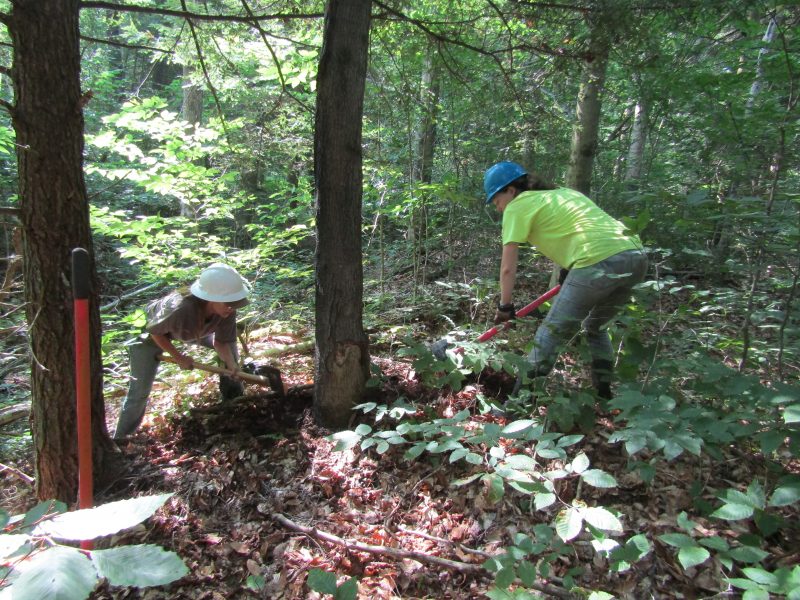by Adam McCully
For most outdoor enthusiasts, the jarring sound of a chainsaw tearing through a tree is seldom the harbinger of good news. Typically, chainsaws mean deforestation and the loss of habitat, or pollution and unnatural development. Of course the worst case scenario is you’re a coed or camp counselor and the revving of a chainsaw means the serial killer you’re trying to elude is closing in fast. However, if you find yourself in the Allegheny National Forest – which is highly recommended as it is hands down one of the most beautiful locations in Pennsylvania, if not the entire United States – the sound of a chainsaw is actually a good thing, because it means that nearby there are conservationists hard at work creating a more sustainable freshwater environment.
The Western Pennsylvania Conservancy and the National Forest Service have combined their resources in an effort towards stream bank stabilization and in-stream habitat improvement, which is a science-tastic way of saying that they’re improving the streams and the watersheds (an area of dry land that drains streams and rainfall into a common outlet) in the Allegheny National Forest. Perhaps improving isn’t the right word since it’s nearly impossible to improve upon what nature has provided. What they’re really doing is reclaiming the streams, or balancing out the scales of man vs. nature.
In the early days of Pennsylvania’s colonization and development, timber was extremely plentiful. Over 90% of Pennsylvania was covered in forest, but due to the high demand of lumber it took less than a hundred years for our state to become a charred and barren landscape. In the 1920’s a conservation and restoration effort was instilled, but the damage had already been done. Drought, erosion, flooding, and fire were the result of this mass deforestation, and even today the ripples of this event can be felt. It’s funny how the different aspects of nature work in unison. Old trees die of natural causes and over time they’re blown over by the wind. These massive logs and knotted roots make their way into streams, creating habitats for a wide variety of organisms and providing a natural defense against floods and erosion. The problem with many of the forests in Pennsylvania is that our trees simply aren’t old enough to follow the natural order. It’ll be decades before most of them start to die off and decay to the point of falling over naturally. That’s where the Western Pennsylvania Conservancy and the National Forest Service come in.

“A lot of our forests in PA are pretty young and don’t have the natural die off that can distribute the wood to the streams. So we’re giving it a little bit of a helping hand by harvesting trees,” says WPC Watershed Manager, Kylie Maland. “We’re speeding along the process.”
By using minimally invasive tactics, members of the WPC and the NFS are creating man-made structures that mimic what nature would have otherwise provided. Chainsaws, axes, shovels, picks, and manual winches (not to mention a fair amount of sweat) are the tools they use to place trees, branches, and root wads in strategic positions and locations throughout the streams of the Allegheny National Forest. In doing so, they’re creating safe habitats for fish and macroinvertebrates (crayfish, blackflies, stoneflies), preventing the erosion of streambanks and the subsequent sediment deposits in the stream, and providing a natural barrier against floodwaters. They’re combining hard, manual labor with engineering techniques and scientific data collection, and – if all goes to plan – they’re starting a trend that will hopefully spread throughout the state and bring us one step closer to an equilibrium between man and nature.
This is hard, back breaking work. There’s no doubt about that. If you’ve ever uprooted a tree by hand you know that it’s a long, slow, agonizing process. Each structure built in the stream requires at least two – and usually three – large trees, so even to build one structure a day is setting a grueling pace. Why use axes and picks when they could just plow over an acre of trees with a D-9 Caterpillar and place them with ease and precision using an excavator? It’d certainly be quicker, but it would also undoubtedly be counterproductive. The whole point of this process is to improve the streams and stream banks, but plowing down the trees and ripping up the ground around them would cause more problems than it would solve. By using techniques that leave a tiny environmental footprint, the conservationists that do this work are ensuring that the natural order is not only restored, but maintained. This will decrease the amount of restoration work that needs to be done in the future. So while at first glance this may seem like doing things the long way around, it’s actually the most efficient means of stream and stream bank restoration. It’s also much more convenient and environmentally friendly to have the conservationists carry their small equipment in and out of these very remote locations each day. The flip side of this would be clearing out pathways and creating roads in order to transport heavy equipment. Again, this would be incredibly counterproductive.

So how does one go about restoring a stream or stream bank to its natural working order? Well the first step is training. While many landowners might hear about this project and decide it would be a good thing to do on their own property, the fact of the matter is this is a delicate procedure, and without the proper training, provided by the National Forest Service, amateurs might end up doing more harm than good. After training comes surveying. Conservationists in the ANF scoured miles of streams to locate the areas most in need of restoration. After the best spots are picked, they need to collect the materials for their restoration structures, namely trees. The conservationists take care to pick trees that are close, but not right next to the stream bank. They also try and choose trees that are either diseased or close to dying. Once the trees are selected, the conservationist team will either cut them down or dig them up by the root. The root wads on the end of trees provide excellent habitats for macroinvertebrates and create a stronger barrier against floodwaters. Once the trees are dug up or cut down, they’re drug using either a small, gas powered winch or a hand winch. The trees are placed in the stream on top of each other in a triangle shape. The triangle shape creates a sturdy barrier against fast moving waters. After all, it takes a lot of work to get these trees in place, the conservationists that put them there don’t want to see them moved downstream by a strong current. But these structures aren’t just built to be sturdy. “This project is very pre-planned,” says Maland. “We have actual designs for each structure. We take the tops of the trees and try to put them in between the logs to fill in some of the void space. When there is a flood event in the future, that will help stem the flow and keep it from getting to a bridge or a culvert. It also helps redirect the flow up into the flood plain which dissipates the energy of the flood water. Any obstacle that the water velocity encounters is going to slow it down, so these structures have cumulative effect on the slowing of flood waters.”
Another aspect of the structures are the habitats they create. “Logs meets in the middle, but when the water is higher it will rush over those logs and create a scour pool. The fish love deep pools and because it’s natural wood and we’re not excavating the hole, there will be different depths and widths of the pool. It creates variability in the habitat which is important for different species of fish and other creatures. Creating this complexity helps improve the biodiversity. The Stone flies, Dobson flies, and (other macroinvertebrates), they lay their eggs in the water, and their babies essentially live in the water… The fish eat the insects so it’s an important part of the food chain.”
It took a lot of hard work to destroy the vast majority of PA’s wilderness. Unfortunately, it’ll take a lot of hard work to restore it. The conservationists working on this project are drenched in sweat before noon, but they attack this restoration project with an unrelenting passion reserved for those who absolutely love their jobs and believe 100% in what they’re doing. While these stream restoration projects have taken off in other parts of the country, this is a flagship project for Pennsylvania. Fortunately, it won’t be long before the benefits become obvious. Deeper pools and richer biodiversity mean more fish, and more fish mean happier fisherman. Floodwaters will have a harder time reaching the roads and pathways laid out for ATV enthusiasts, and while it won’t keep the mud puddles from forming it will prevent the roads from washing out. If all goes according to plan, this won’t be the last time you hear about a stream restoration project taking place in PA.

















